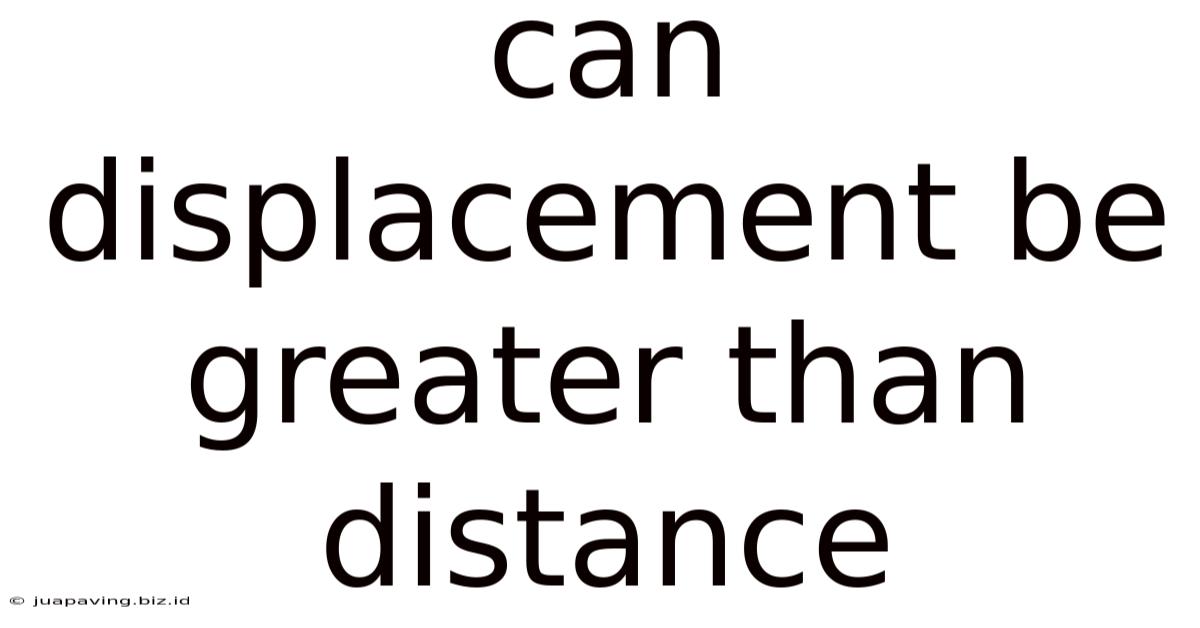Can Displacement Be Greater Than Distance
Juapaving
May 10, 2025 · 4 min read

Table of Contents
Can Displacement Be Greater Than Distance? Understanding the Difference
The concepts of displacement and distance are fundamental in physics, particularly in kinematics, the study of motion. While they both relate to the movement of an object, they represent different aspects of that movement, leading to a common question: can displacement be greater than distance? The short answer is no. However, understanding why requires a deeper dive into the definitions and implications of each term.
Defining Distance and Displacement
Let's start by clearly defining each term:
Distance: The Total Ground Covered
Distance refers to the total length of the path traveled by an object. It's a scalar quantity, meaning it only has magnitude (size) and no direction. Imagine you're driving from point A to point B. If you take a winding road, the distance you travel is the actual length of that winding road, regardless of the straight-line path between A and B. You might travel 10 miles, even if the "as the crow flies" distance between A and B is only 7 miles.
Key characteristics of distance:
- Scalar quantity: Only magnitude.
- Always positive: Cannot be negative.
- Path-dependent: Depends on the actual path taken.
- Measured in units of length: Meters, kilometers, miles, etc.
Displacement: The Straight-Line Path
Displacement, on the other hand, is a vector quantity. This means it has both magnitude and direction. Displacement measures the shortest distance between the starting point and the ending point of an object's motion. Using our driving example, the displacement is the straight-line distance from point A to point B, regardless of the route taken. This would be the 7 miles in our example.
Key characteristics of displacement:
- Vector quantity: Magnitude and direction.
- Can be positive, negative, or zero: Direction is crucial. A negative displacement simply indicates movement in the opposite direction.
- Path-independent: Only considers the initial and final positions.
- Measured in units of length: Meters, kilometers, miles, etc., often accompanied by a direction (e.g., 7 miles east).
Why Displacement Cannot Be Greater Than Distance
The core reason displacement cannot be greater than distance lies in the very definitions of these quantities. Displacement represents the shortest distance between two points, while distance represents the actual distance traveled. The shortest distance between any two points is always a straight line. Any other path taken will inevitably be longer.
Think of it like this: imagine walking around a square with sides of 10 meters each. The distance you've traveled is 40 meters (10m x 4 sides). However, your displacement is zero! You've ended up back where you started, so the straight-line distance between your starting and ending points is zero.
Illustrative Examples
Let's explore some more examples to solidify the difference and demonstrate why displacement can never exceed distance:
Example 1: A Simple Straight Line
A car drives 5 kilometers due north. In this case, both the distance and displacement are 5 kilometers north. They are equal.
Example 2: A Round Trip
A person walks 2 kilometers east, then 2 kilometers west. The distance traveled is 4 kilometers (2 km + 2 km). However, the displacement is zero because the person ends up back at their starting point.
Example 3: A More Complex Path
Imagine a runner completes a 400-meter track race. The distance covered is 400 meters. However, the displacement is zero because the runner finishes at the same point where they started.
Example 4: Non-Circular Path
A hiker walks 3 km north, then 4 km east. The distance is 7 km (3 km + 4 km). The displacement, however, can be calculated using the Pythagorean theorem: √(3² + 4²) = 5 km northeast. The displacement (5 km) is less than the distance (7 km).
Applications and Importance
The distinction between distance and displacement is crucial in various fields:
- Physics: Understanding motion, velocity, and acceleration. Calculating velocity requires displacement, not distance. Average velocity is displacement divided by time, while average speed is distance divided by time.
- Navigation: GPS systems utilize displacement to determine the shortest route between two points.
- Mapping: Cartography employs displacement for accurate representation of locations and distances on maps.
- Engineering: Designing efficient routes for transportation systems and infrastructure.
Common Misconceptions
A common misconception is that displacement can be greater than distance. This misunderstanding stems from a lack of clear understanding of the vector nature of displacement and the fact that it represents the shortest distance. Distance is always the total path length; displacement is always the straight-line separation between the start and end points.
Conclusion
In conclusion, displacement can never be greater than distance. This fundamental principle is a cornerstone of kinematics and has far-reaching implications across numerous scientific and engineering disciplines. Understanding the difference between these two quantities is critical for accurately describing and analyzing motion. Remembering that distance is the total path length and displacement is the straight-line distance from start to finish eliminates any confusion about this important distinction. While they both measure aspects of movement, their distinct natures—scalar vs. vector—lead to fundamentally different calculations and interpretations. The next time you're considering the movement of an object, remember to distinguish carefully between the distance traveled and the overall displacement.
Latest Posts
Latest Posts
-
Describe The Structure Of A Triglyceride
May 10, 2025
-
How Many Lines Of Symmetry Does The Following Figure Have
May 10, 2025
-
Como Se Dice 815 En Ingles
May 10, 2025
-
Concept Map Steps Of Cellular Respiration
May 10, 2025
-
Definition Of A Producer In An Ecosystem
May 10, 2025
Related Post
Thank you for visiting our website which covers about Can Displacement Be Greater Than Distance . We hope the information provided has been useful to you. Feel free to contact us if you have any questions or need further assistance. See you next time and don't miss to bookmark.